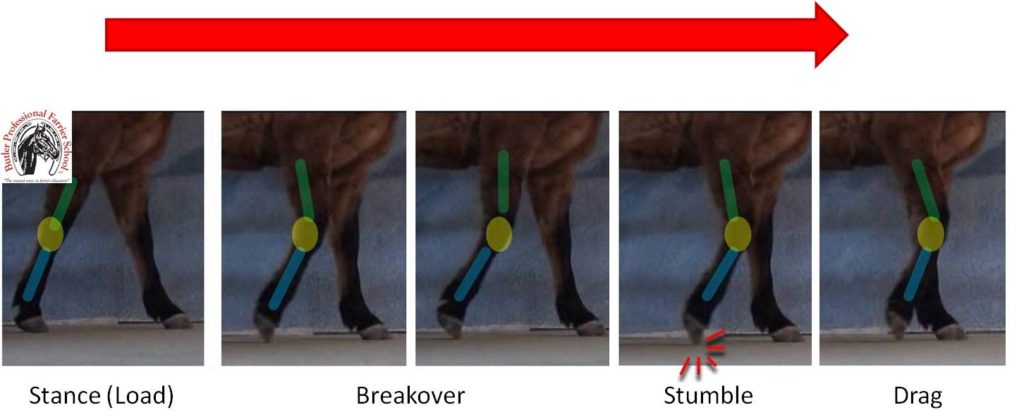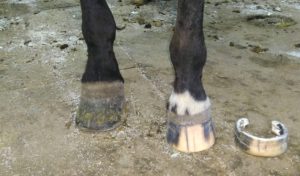Stumbling
Riding a stumbling or tripping horse can be aggravating and dangerous. Stumbling occurs when the horse’s toes do not entirely clear the ground and the gait is interrupted. All horses will inevitably trip occasionally depending on the ground they cover, but some horses stumble consistently regardless of the terrain. In the case of these “stumblers,” it is helpful to determine the root cause and try to eliminate or at least alleviate the problem. It is tempting to blame the farrier because it is a foot problem but there are many factors that go into a horse’s movement besides just the feet. There are several reasons why a horse might stumble.

Stumbling occurs when the foot does not clear the ground. This horse stumbled because of a popped knee in the right front leg. The swelling and arthritis caused the horse to not bend the knee as much as it normally would. This made the toe of the foot catch the ground. The foot had a dubbed appearance from dragging the foot each time the horse took a step.
Age. Horses, like humans, must learn to walk and run. Horses learn the basics earlier than humans do, but there are still awkward phases of learning to use the limbs. The older a horse gets, the more confirmed it will become in its gait and stumble less. Most horsemen recommend not heavily training a horse until after a horse is three years old. This gives the horse time to properly develop and learn to use its legs. Even so, a three-year old horse may stumble early in the training process because the horse is learning a new skill—to move with weight on its back.
Young horses may stumble due to lack of training and experience, but older horses may stumble also because of stiff joints, fatigue and other discomforts. As a horse ages, they tend to get more tired and arthritic so they may not try as hard to lift their feet.
Injuries. Horses that injure their legs may develop a stumble as the injury heals. Other problems may be chronic. Stumbling can often be a symptom of a problem higher in the limb. Horses with stiff knees, shoulders, hips, stifles and hocks will not bend the leg as much in order to clear the ground. Checking higher up the limb for swelling, stiffness and bony growths (exostosis) may give a clue into why a horse stumbles.
Laziness. Some horses are lazy. They stumble because picking up their feet to clear the ground is a lot of work! These horses usually will stop dragging their feet when a rider wakes them up with spurs or other encouragement cues.
Rider. An inexperienced rider can cause a horse to stumble by not sitting properly or pulling too much on the bit (or not enough). An unbalanced rider that bounces all over the horse is one of the major causes of stumbling for the horse.
Sickness. Some horses may stumble as a result of some kind of sickness. EPM (Equine protozoal myeloeencephalitis), West Nile and other neurological diseases can cause uncoordinated movement. EPM is spread mostly by opossum urine while West Nile is caused by mosquitoes. Getting horses properly vaccinated and taking precautions by limiting horse’s contact with disease carrying animals are good preventative measures.
Conformation. A horse with an underrun heels, is more likely to stumble due to the low angle of the foot. These horses tend to grow more toe because there is more weight bearing on the heel. The greater amount of toe makes a greater obstacle for the horse’s foot to clear the ground. Along with this, the internal structures of the foot (i.e. deep flexor tendon, navicular bone) may be strained and the resulting discomfort will alter the horse’s movement.

The owner of this horse complained about the horse stumbling. This picture was taken after trimming the left front foot and before trimming the right front foot to illustrate the likely reason for the stumbling. The shoeing interval had been stretched longer than the normal 6 to 8 weeks. After approximately 8 months of growth, nearly two and a half inches of foot was removed. The horse stopped stumbling.
Regardless of a horse’s conformation, a long toe will likely cause stumbling. It would be like a person wearing clown shoes! It is important to schedule regular hoof care for the horse (every 6 to 8 weeks) to prevent the horse from growing out of balance. A skilled farrier can also help a horse by forging a rocker toe into the shoe to encourage easier breakover for the horse. On a horse that is just to be trimmed, dressing the foot on the stand as well as heavily rolling or beveling the foot with a rasp will help breakover.
Any of these factors (or a combination of them) can cause a horse to stumble. The farrier’s role in foot balance is extremely important but other issues should not be ignored. Consistent stumbling is usually a symptom of a greater problem, so determining the cause is critical to prevent this potentially fatal problem for the rider.
To learn more about proper trimming and shoeing techniques to help breakover, check out Essential Principles of Horseshoeing.
Related Posts
-
by Doug Butler PhD, CJF, FWCF Butler Professional Farrier S...Nov 15, 2013 / 0 comments
-
What is the most common lameness cause you have seen in hors...Oct 28, 2009 / 0 comments
-
“Doug, I attended your Horse Expo seminar this past Ma...Apr 22, 2010 / 0 comments
Blog Categories
- Anatomy
- Best Business Practices
- Conformation
- Current Events
- Customer Service
- Draft Horse Shoeing
- Equine Soundness
- Essential Anatomy Kit
- Farrier Careers
- Farrier training
- Foal soundness
- Horse Care
- Horse Foot Care
- Horse Owner Tips
- Horsemanship
- Horseshoeing
- Horseshoeing History
- Iron and Forge Work
- Student Spotlight
- Uncategorized
- Veterinary Care
Blog Archives
Contact Us
Butler Professional Horseshoeing School
495 Table Road
Crawford, NE 69339
(800) 728-3826
jacob@dougbutler.com
Subscribe to Our Blog
Get Our Free e-Book!
If you think you want to become a farrier (or know someone who does), this book can help you make that decision. Horse owners will learn the importance of choosing a qualified farrier and how to select the “right” one.
[ Get the e-Book Now! ]
- Follow:
